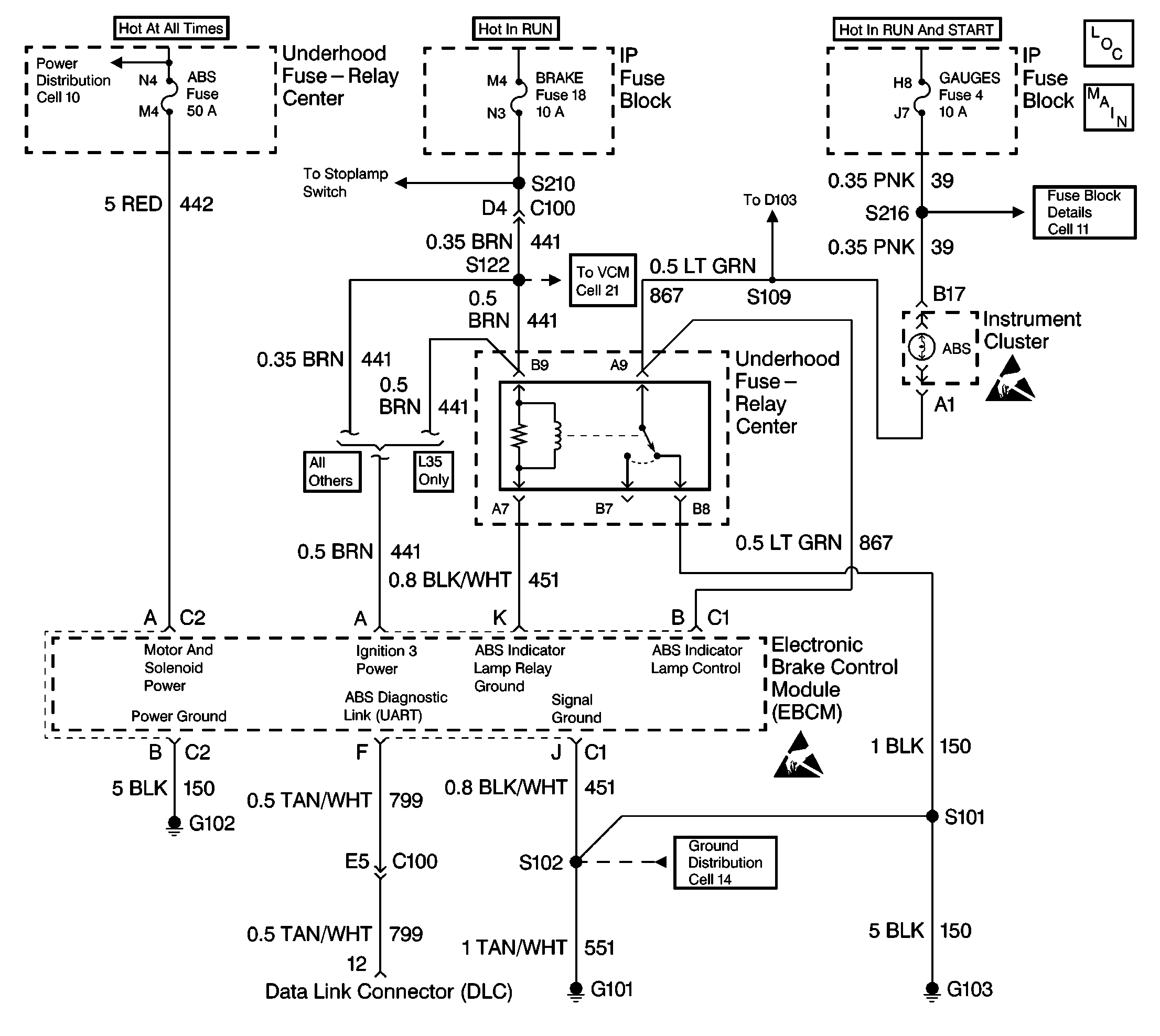
Circuit Description
The EBCM controls the ABS indicator lamp illumination by supplying a ground to the EBCM 10-way terminal B. When the vehicle is started or the ignition is turned to the RUN position, the ABS indicator should illuminate for three seconds and turn offThe EBCM controls the ABS indicator lamp in three modes of operation. Under normal conditions with the ignition switch set to the RUN position, 12 volts is supplied from connector C1 terminal B of the EBCM and the ABS indicator lamp is off. If conditions in the EBCM warrant turning the ABS indicator lamp on, ground is supplied from connector C1 terminal B of the EBCM to turn the lamp on. This would normally occur during the ABS bulb check, when the ignition is turned to the RUN position and the ABS indicator lamp flashes for 3 seconds. Otherwise, this condition would occur when a DTC which requires turning the ABS bulb on has set. If conditions warrant, and the EBCM or the brake pressure warning switch turns the BRAKE warning lamp on, the ABS indicator lamp will also be turned on through diode D103. If the EBCM 10-way connector is removed while the ignition is set to RUN, a ground normally supplied from the EBCM through connector C1 terminal K is removed from the antilock brake indicator relay, and the relay deenergizes. This causes relay contacts A9 and B8 to close, which switches a constant ground to the ABS indicator lamp circuit.
Diagnostic Aids
If the ABS indicator lamp is off constantly with no DTCs set, an open circuit is present between the instrument panel cluster and the EBCM, the GAUGES fuse is open or an open is present between the fuse block and the instrument panel cluster.
Test Description
The numbers below refer to the steps in the diagnostic table:
-
This step manually (with fused jumper) turns on the ABS indicator lamp.
-
This step checks the supply voltage to the instrument cluster.
-
This step decides between an ABS indicator ground circuit (CKT 867), or instrument cluster fault.
-
This step checks for an open in CKT 867.
-
This step checks for an open in CKT 33 between terminal H in the 10-way EBCM harness and S109.
Step | Action | Value(s) | Yes | No |
|---|---|---|---|---|
1 | Was the Diagnostic System Check performed? | -- | Go to | |
Does the ABS indicator lamp turn on? | -- | |||
Is the voltage measured within the range specified? | Greater than 10V | |||
Is the voltage measured within the range specified in the Value(s) column? | Greater than 10V | |||
Does the ABS indicator lamp turn on? | -- | |||
6 | Inspect the 10-way EBCM harness connector for signs of damage or corrosion. Is the connector OK? | -- | ||
Does the ABS lamp turn on? | -- | |||
8 | Repair the open between terminal H in the EBCM 10-way wiring harness connector and S109. Is the repair complete? | -- | Go to | -- |
9 | Replace the EBCM. Refer to . Is the repair complete? | -- | Go to | -- |
10 | Repair the ABS 10-way wiring harness connector. Refer to. Is the repair complete? | -- | Go to | -- |
11 | Repair the open or the high resistance in CKT 867. Refer to Is the repair complete? | -- | Go to | -- |
12 | Replace the ABS indicator lamp, of repair instrument cluster. Is the repair complete? | -- | Go to | -- |
13 | Repair the open in CKT 39, and check GAUGES fuse 4 for an open. Refer to . Is the repair complete? | -- | Go to | -- |
